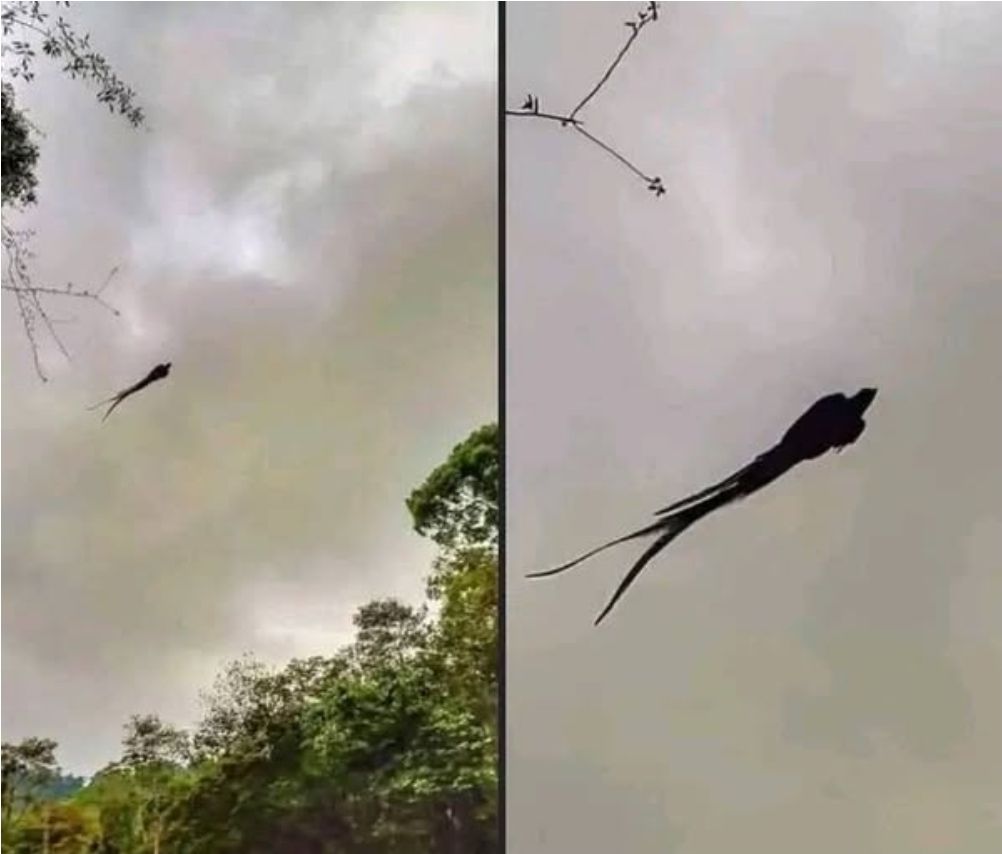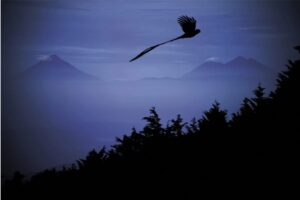The Quetzal: The Bird Too Beautiful — and Too Free — to Be Caged…
There are some creatures in this world that don’t just exist — they remind us what freedom looks like. For Mexico and much of Central America, that creature is the quetzal — a bird so striking, so spiritually symbolic, that ancient civilizations built legends around its flight. If you’ve ever seen one — even in photos — you’ll understand why.
A Glimpse That Stopped the Internet. Earlier this year, a photo taken near Frontera Corozal, Chiapas, went viral. At first glance, many online thought it showed something eerie — a shadowy, ghost-like figure gliding through the mist. Some even joked that it looked like a Dementor from Harry Potter.
But it wasn’t anything sinister. It was a quetzal, soaring in mid-flight, captured at the perfect angle — its long emerald-green feathers trailing like ribbons, its scarlet chest glowing faintly against the fog. For those who recognized it, the image was more than just beautiful — it was emotional. Because seeing a quetzal in the wild today is rare.
And it’s not just rare because they’re shy. It’s because they’re disappearing.
Why the Quetzal Matters So Much
The quetzal isn’t just another tropical bird. It’s a living piece of Mesoamerican history. Centuries ago, the Maya and Aztecs saw it as a sacred creature — the embodiment of freedom and divine power. The Maya called it Q’uk’umatz — “the feathered serpent” — and connected it with Kukulkán, the god of the sky and rebirth. The Mexica (Aztecs) associated it with Quetzalcóatl, the god of wisdom, wind, and life itself.
Its shimmering green feathers were more valuable than gold. But no one ever killed the bird to collect them. The feathers were gathered from fallen plumes, because taking the life of a quetzal was seen as a spiritual offense — like silencing freedom itself.
Up close, the quetzal is a masterpiece of natural design. Male quetzals have vivid red chests and shimmering emerald bodies that shift color under sunlight — sometimes blue, sometimes green, depending on the angle. Their long tail feathers can stretch up to a meter in length, fluttering like silk ribbons in flight. Females, on the other hand, wear subtler shades — olive and gray, without the extravagant tail — blending seamlessly into the forest canopy.
But the most fascinating thing isn’t how they look. It’s how they live.

The Bird That Cannot Live in Captivity
The quetzal is a symbol of absolute freedom for one reason: It simply cannot survive in captivity. People who have tried to keep quetzals as pets quickly discover the tragic truth — they refuse to eat when confined. They slowly starve themselves, choosing freedom over life in a cage. That’s not poetic exaggeration; it’s biological fact. Their biology is so finely tuned to the cloud forests they inhabit — the humidity, temperature, and altitude — that even slight changes cause them distress. It’s one of those rare cases in nature where an animal seems to live by a philosophy:
“I would rather die free than live confined.”
Today, wild quetzals can still be found in parts of southern Mexico (especially Chiapas), Guatemala, Costa Rica, and Panama — but only in dense, misty cloud forests. They prefer elevations between 1,000 and 2,000 meters, where the air is cool and moist, and trees grow thick with moss and epiphytes. Their diet includes:
Aguacatillos — small wild avocados that they swallow whole and later regurgitate, helping spread seeds throughout the forest. Insects, frogs, and small lizards. Like the forests they depend on, their numbers are thinning. Deforestation, illegal pet trade, and habitat fragmentation have pushed them into endangered status across much of their range.
A Delicate Balance of Life
Nature has its own way of designing balance. The quetzal, for example, plays a vital role in the forest ecosystem. By eating aguacatillos and dispersing their seeds, it helps regenerate trees that form the very habitat it depends on — a perfect cycle of give and take. When that cycle breaks — when forests are cut down for farmland or logging — the quetzal disappears too. And when the quetzal disappears, the forest loses part of its heartbeat.

Conservation programs in Mexico and Central America are working to protect what remains of this bird’s habitat. In Chiapas, rescued quetzals are being rehabilitated at the Miguel Álvarez del Toro Zoo before being reintroduced into the wild. In Guatemala, the Biotopo del Quetzal reserve protects one of the last thriving populations. Ecotourism projects now teach local communities that a living quetzal, flying free, is far more valuable than one taken for trade. Slowly, the idea is shifting — from possession to preservation.
When that photo of the quetzal in flight spread online — mistaken at first for something supernatural — people were reminded of something simple but powerful: How easy it is to lose sight of beauty when it’s rare. For locals near the Chiapas border, that photo wasn’t just an image — it was a reminder that the quetzal still exists. That despite everything, a few still soar through the mists, their feathers catching the same light their ancestors once did.
Lessons from a Bird That Refuses Captivity
There’s a quiet wisdom in the quetzal’s story — a lesson that extends beyond forests and feathers. Freedom has a cost. The quetzal won’t live in a cage, even if it means death. It’s nature’s reminder that life without freedom isn’t really life. Every ecosystem is a chain. Remove one part — like a forest, or a single species — and the balance collapses. Wonder begins with awareness. The more we learn about the world around us, the harder it becomes to take it for granted.
The quetzal isn’t just a national emblem of Guatemala or a mythical creature in ancient art — it’s a mirror reflecting what happens when we stop listening to nature. Its story isn’t about extinction. It’s about resilience — about a species still fighting to exist in a world that keeps closing in. So if you ever find yourself walking through a misty forest in southern Mexico or Central America and you catch a flash of red and emerald disappearing into the trees — stop for a moment.
You’ve just witnessed something sacred. A bird that has lived in myths, survived centuries of change, and still refuses to be caged.
🕊️ Quick Facts Few People Know:
Quetzals can only nest in natural tree cavities — they can’t dig their own holes. Both parents share incubation duties — a rare trait among birds. Their feathers were once used in royal Aztec and Maya clothing — but plucked without killing the bird. Their tail feathers can grow longer than their entire body.
Their name lives on in Guatemala’s currency: the quetzal.
Some animals remind us to adapt. The quetzal reminds us not to forget who we are. A creature of the sky, born to fly free — just like the forests it calls home.